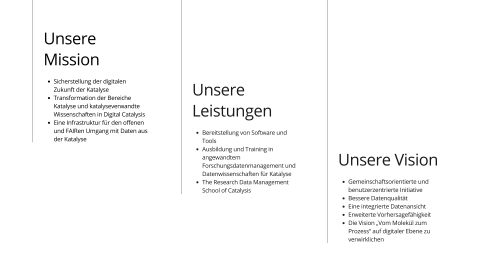NFDI4Cat aims to unite the various disciplines of catalysis.
Catalysis is a highly complex and interdisciplinary scientific field that enables the efficient production of a wide range of products across industries and at different production scales. As such, catalysis is a key technology in addressing major global challenges like sustainable energy supply and climate change.
Currently, data management in catalysis is mostly organized at the institutional or research group level, following local conventions. Cross-cutting repositories and standards for storing data, including metadata, exist only in a rudimentary form.
To fully unlock the potential of catalysis research, a fundamental shift is needed in how catalysis and related disciplines, such as chemical and process engineering, manage data. Bringing together the various catalysis disciplines under a shared approach to data management is the central challenge.
It is precisely for this reason that the NFDI4Cat consortium was established as part of the National Research Data Infrastructure (NFDI) initiative. NFDI4Cat focuses on catalysis-related sciences and works to develop a shared, digital foundation for the future of the field.
Research data in the field of catalysis are generated in several stages:
Typically, the process begins with the synthesis of a catalyst material using various starting materials and synthesis methods (synthesis data). The synthesized catalyst is then tested in a reactor under a series of varying reaction conditions, such as temperature, pressure, or flow rate, while being exposed to reactants like gases or liquids. The resulting products are analyzed for their composition and quantity using analytical methods such as mass spectrometry or gas chromatography (reaction data).
Catalysis research aims to uncover relationships between the structure of a working catalyst and its activity. Ideally, this is achieved through operando measurements that directly observe catalysts under relevant reaction conditions, often supported by quantum chemical calculations. Structural properties are determined before, during, or after the catalytic reaction using materials analysis techniques such as spectroscopy, diffraction, or absorption methods (characterization data). The reaction data are used to calculate the performance of the catalyst, which can be expressed in various forms, such as concentrations, conversion rates, or selectivity (performance data).
These data feed into the modeling of reaction kinetics (molecular modeling), reactor simulations (multiscale modeling), and process simulations. Based on these simulations, catalytic reactors and processes can be designed. The success of this approach is driven by both experimental and computational methods, which are often carried out separately by different experts. While the overall workflow and fundamental concepts are similar across the different subdisciplines of catalysis, each tends to use slightly different approaches, nomenclature, experimental methods, and descriptors for properties and performance.
Currently, data management in catalysis is mostly organized at the level of individual institutes or research groups and relies on local conventions. Cross-cutting repositories and standards for how data and metadata should be stored exist only in rudimentary form e.g., in biocatalysis or theoretical catalysis. As a result, data publication still plays a minimal role in the field.
The Future of Research Data in Catalysis
To address current challenges and fully unlock the potential of catalysis research, a fundamental digital transformation is needed, both within catalysis and in related fields such as process and chemical engineering. The need for a coordinated, shared approach to harness the full value of catalysis data is thoroughly outlined in the GeCatS publication The Digitalization of Catalysis-Related Sciences. The NFDI4Cat consortium aims to enable and accelerate the transition from the current state toward digital catalysis research.
Key elements required for this transformation include the harmonization of concepts, vocabularies, and data formats, as well as the development of interconnected information architectures that allow for the storage and exchange of semantically rich data. These data infrastructures are essential for leveraging advanced analytical methods, especially those based on artificial intelligence.

